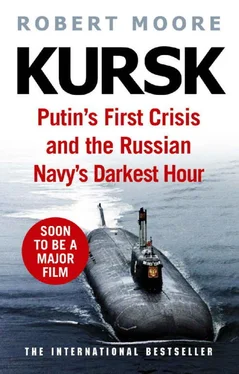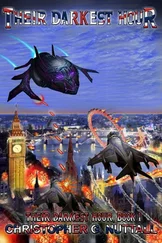If Lyachin and his senior officers had time to think that their predicament could not get any worse, they had only to glance at the depth gauges, which were still operating, to discover that the Kursk was now being driven downwards by her own power and by the weight of the water that was pouring into the forward compartments through broken internal pipework.
The shallow water of the southern Barents Sea now presented its own grave danger. A lack of depth is a hazard in submarine operations, depriving a commanding officer of any margin for error. Even if Lyachin managed to make command decisions, he was desperately short of time. The average depth of the Barents Sea is 220 metres, and there are areas south of Bear Island where it reaches just under 600 metres. But the Kursk was in water only 115 metres deep. Instead of several minutes in which to save his submarine, Lyachin had only seconds.
In the wrecked torpedo room, the laws of physics were remorselessly at work. The inexorable reaction of fuel and HTP cannot be halted; it is self-sustaining, like an avalanche. Torpedoes give you no second chance. Extinguishers and other firefighting equipment, even if you have time to deploy them, are worthless. The reaction will stop only when the chemicals – in this case a thousand kilograms of HTP and five hundred kilograms of kerosene – are used up. The forward compartment became a giant combustion chamber: the fuel-fire of the torpedo, the mix of kerosene and high-test peroxide, raging to an incredible heat. The torpedo racks, the patchwork of wiring, the steel bulkheads and the casings of the remaining twenty-three weapons began to melt. The torpedoes – not the practice weapons, but the actual warload – were either still lying jammed on their racks or were strewn among the debris from the explosion.
The warheads were, essentially, cooking.
Explosives suffer spontaneous combustion at around four hundred degrees Celsius (725°F). The temperature in the torpedo room was soaring well into the danger zone.
The uncontrolled dive of the submarine lasted exactly 135 seconds, before the second explosion tore through the compartments. It is estimated that the Kursk travelled around a quarter of a mile between the detonations, descending 107 metres. The 23,000-ton ship crashed into the seabed at only a slight angle but with shuddering force.
The second detonation was a truly seismic event, nearly 250 times greater than the initial blast. All the warheads and the fuel in the remaining torpedoes ignited almost simultaneously, an explosion that registered 3.5 on the Richter scale. Scientists who have studied the seismic patterns generated by this second explosion say that it occurred at the same depth as the seabed – at 115 metres. That suggests, but does not prove, that the second detonation was triggered by the crash into the seabed rather than the warheads reaching spontaneous combustion. In fact, either could have been true. The fire inside the torpedo room was generating an inferno, temperatures now reaching several thousand degrees.
The pressure hull is far stronger than the internal bulkheads that separate the compartments. The high-strength, high-yield steel of the hull can withstand pressure up to a depth of 1,000 metres, whereas the bulkheads would yield at a tenth of that. But the scale of this second explosion made such distinctions barely relevant. The second blast ruptured the hull only a fraction of a second after the forward compartment’s bulkhead was demolished. Directly above the torpedo storage area, on the starboard side, the shock wave tore out ten square feet of the pressure hull. The thick steel was punched out, as if by a giant fist. The outer hydrodynamic hull, just a third of an inch thick, stood no chance.
The shock waves then raced through the ocean, hammering into the seabed. Into a compartment that had been devastated by fire and explosion now roared icy Arctic waters, just a few degrees above freezing and under sufficient pressure to cut a man in two. Had the boat been close to the surface, the torpedo compartment, with its two-square-metre hole in the hull, would have filled up at a rate of 90,000 litres a second; at a depth of over a hundred metres, under the additional water pressure, the compartment filled up much faster. In just sixteen seconds it was entirely flooded. The sailors and officers in the command centre who had survived the first explosion stood no chance now. With the bulkhead destroyed between the torpedo room and the second compartment, they faced a crushing wall of water.
The second blast left all four forward compartments shattered. Rudakov and his team of twenty-four officers and sailors in the third compartment were protected only by the steel bulkhead that separated them from the control room, and that was ripped open as if it were made of paper. The fourth compartment, home to the kitchen, the canteen and many of the living and sleeping quarters of the submariners, was wrecked. Those trapped here included Oleg Yevdokimov, the young chef who had regarded his transfer to the Kursk as a blessing because Captain Lyachin’s watchful eye meant he would escape the bullying that was so prevalent elsewhere in the Russian armed forces.
As the shock wave punched its way through the large fourth compartment, the successive internal bulkheads began to slow the velocity of the blast. The explosion now became a titanic contest between the tremendous force of the blast and the engineering rigour of the submarine. The question was how far the destruction would extend back into the aft of the Kursk . The fifth compartment housed the twin nuclear reactors. They were encased by walls of extraordinary strength, surrounded by five inches of hardened high-grade steel capable of resisting pressure to 1,000 metres, the same resilience as that of the inner hull.
The shock waves wreaked havoc in the first four compartments, smashing through the bulkheads up to the nuclear reactors. There, the bulkhead held. It was buckled and twisted but, astonishingly, the steel held. An earlier generation of Russian atomshiks had scornfully described their submarines as ‘nuclear tractors’, because of the rudimentary engineering that surrounded the reactors. But there was no mocking the construction of the Kursk . Against all the odds, a team of designers and engineers had built in a huge safety margin, and their work had passed the supreme test. The blast was halted at the most critical point, before the shock waves dislodged the control rods. If those rods had not been driven safely home in time, the reactors would have continued running, and without proper water circulation they would have become hotter and hotter. In a short time the fuel could have melted its way through the reactor, a highly radio-active lump burning into the seabed and poisoning the ocean.
The world had come one bulkhead away from a nuclear disaster. Five inches of precious steel made sure this was a submarine accident, not a regional disaster.
In the event, the control rods were driven safely home, either by an automatic safety mechanism or by a sailor reacting with lightning speed to the impending disaster. Either way, the nuclear reactors ‘scrammed’, automatically shutting down. The pressure in the steam plant plummeted as the turbogenerators stopped. The batteries in the forward compartments were destroyed. The Kursk now lay inert on the seabed, without electrical power.
Broken bodies floated in flooded passageways. Driven into the upper part of the bow compartment’s ceiling were the remnants of the 65-76 torpedo that had been in the starboard tube. One of the sailors in the command centre was blown backwards and upwards with such power that his corpse was later found embedded in the ceiling of the second compartment.
Читать дальше












